 Royal Navy – 8 ships (2 cancelled), 2 batches 1962-2006
Royal Navy – 8 ships (2 cancelled), 2 batches 1962-2006HMS Devonshire, Hampshire, Kent, London, Fife, Glamorgan, Antrim, Norfolk
The new “county” are missile destroyers
The Royal Navy in the 1950s the needed a new “county class”, but at the time it seemed obvious that they would have been armed with missiles. Development started in 1944 already until various projects (from the air force, army and navy) were coordinated under a single authority. From there, a ship was cast around the new promising SAM in development, the Sealug missile. Debate raged about what these new ships would be, between those who wanted a few cruisers, possibly hyrbids, or a serie of modern destroyers. It was resolved in 1957 for good and the design of the new missile destroyers was finalized around the Seaslug. And thus, appeared the first missile destroyers in Europe, in service until the 1980s, still soldiering under foreign flags until …2013 for the last one. For twenty years the County class really redefined the Royal Navy, helping its transition around a set of new missions.
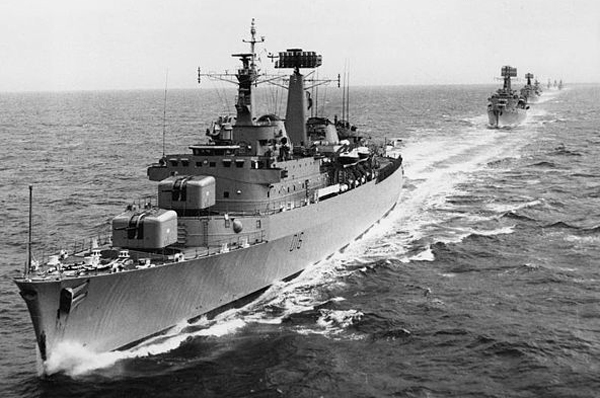
HMS London 1971, IWM
About the class name: Given informally to a serie of pre-deadnought battleships started at the turn of the century, then a cruiser serie before WW1, and a large serie of heavy cruisers of the interwar, battered veterans of WW2 from the Atlantic to the Pacific and Mediterranean. The next class was composed of missile destroyers. From battleships to destroyers it seems like a downgrade, but reflected perfectly the hope placed in modern missile destroyers in 1960. They were supposed to definitely make gunnery obsolete. Largely pioneered by USN early conversions in the late 1950s, the Royal Navy invested in this field also in the late 1950s. However developing at the same time the missile, the related electronics and its launcher ship was quite an endeavour in a largely diminished economy, even in the context of the cold war. Despite of this, ten were ordered, the first dedicated missile ships of the Royal navy, active for some in other navies (Pakistan and Chile) until 2006, so about forty four years. For modern missile vessels it remains almost unprecedented and a testimony to the ability to upgrade their large hull. In the Royal Navy the spent twenty years in service on average. The current “county” class is the current Duke class missile Frigate.
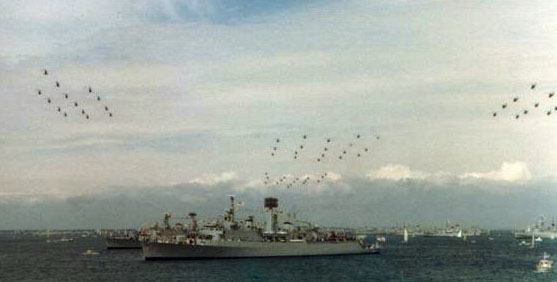
country class DD in a 1980s Fleet review
British missile Development 1952-58
The development of missiles during WW2 – namely German guided bombs such as the Fritz-X 1 trigerred a wave of interest, after some spectacular results (such as the sinking of the Italian battleship Roma in November 1943). Missile development in Great Britain did benefited from some German intel (via Operation Surgeon) and outside acquiring German expertise on the matter (100 German scientists move to UK), there was already the will to built up missile development, which took twenty years, notably before the advent of antiship vectors such as the Sea Eagle and Sea Skua. But development of SAMs started much earlier: On 16 March 1944 indeed, the first meeting of the “Guided Anti-Aircraft Projectile Committee” (GAP Committee) was held, to discuss missile developments, while The Admiralty Signals Establishment in charge of radars and notably radar lock-on devised the LRS.1 fire-control system used to target distant targets, like high altitude bombers. Similar programs were ongoing in the USA, soon leading to the development of a the “T” family of missiles (see USN guided missiles cruisers).
The Navy in 1944 decided to combine these reasearches with the British Army project Brakemine, creating the LRS.1’s Type 909 radar. It was to be combined with a missile, provisionally called LOPGAP(“Liquid Oxygen and Petrol Guided Anti-aircraft Projectile”), with a reach of 50,000 ft (15,000 m) at 700 mph (1,100 km/h). No ship was envisioned to carry those at that point, but reconverted cruisers possibly such as the Tiger class in construction.
The first missiles were tested in 1945: Fairey’s own project, Stooge, and the LOPGAP, based in March 1945 on converted QF 3.7-inch air-aircraft gun mounts. However in 1946 to have a better coordination, these competitive projects were unified under the same roof, the Royal Aircraft Establishment’s (RAE). By January, in the 1947 Navy review, the program was for the first time given the name “Seaslug”. It went on in 1947-48 as a single-stage vertical vector with 200 lb (91 kg) warhead and overall weight of 1,800 lb (820 kg). The goal was for it to enter service in 1957, leaving quite a development time. However in 1952-53 specifications started to change: In 1954, another review of the Navy for future operations considered now instead of a “hot” war with the Soviets a series of “warm wars” in the third world (which proved quite accurate). This brought all out cancellation of a future all-gun cruiser classes, conversion of ww2 destroyers to Type 15 frigates, and with an air cover no longer sufficient by carriers a need for missile task-force groups became the new focus. Carrier construction and detention was stopped to four, and so funds were secured to accelerate missile ship development. In October 1954, a new design emerged with only self-defence gund and a single twin launcher for a missile, likely to to be the finalized Seaslug.
Designs were continually modified to find the best arrangements:
-1953 mid-sized cruiser: 15,000 long tons, 60 to 90 missiles, crew 900. Admiral Ralph Edwards peferred smaller ships with 10 to 20 missiles each. However room for these weapons and operating crew needed a larger ship.
-May 1955: New plans for designs were compared: The largest ships were around 9,850 tons, down to 4,550 tons, so destroyer size. After the comparison and revision process, plans finally fell on what became the County-class destroyers. The design was refined time and again and finalized enough in 1957 (the date to reach for operational missiles) to be authorized. However the seaslug program was nowhere complete at that time. The RTV.1 was demonstrated its beam riding in October 1956, but there were concerns about the propellant and safety onboard the ships. Tests went on at the Clausen Rolling Platform at RAE Aberporth, and from the HMS Girdle Ness in 1958, 1959 and until 1961, still nowhere near completion or operational status. At least the choice of radar was fixed on the Type 984 radar in 1955.
A final tests serie at sea (16 successful firings) had the missile cleared at least for service in 1961. 250 launches later saw the Seaslug Mark 1 (GWS.1 for the Royal Ordnance) entering final service in 1962 on the County-class while the earlier Seaslug-armed cruisers were cancelled in 1957 already. In 1958, a class of ten ships was envisaged for about £6–7.5 million each. It was the equivalent indeed of the four large, Seaslug-armed, 15,000-ton cruisers at first estimated at £14 million each. These were based on an upgraded Minotaur-class cruiser (1951), their design finalized in early 1955 (see WW2 British cruisers). The final four County-class ships were delayed in 1960 as discussions went on for a large anti-submarine escort carrier instead. They were approved in 1963 as a stopgap, while the last two were cancelled.
County class design development 1951-1959
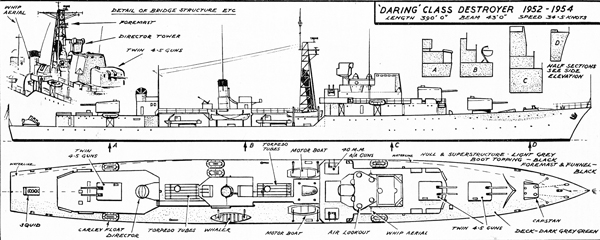
Daring class destroyers
The class was designed, in part as a compromise between factions, as a hybrid cruiser-destroyer. Its dimensions were indeed similar to the recent 1951 Mk.3 improved Dido-class cruiser planned for the Korean war emergency. For “destroyers” they were much larger than any previous RN destroyers such as the 1946, 2,800 ton Daring class, themselves considered as “super destroyers” by PM Winston Churchill in 1952. Like Admiral Andrew Cunningham he foresaw in 1944 aa evolution into an hybrid 3,500 ton vessels specialized as AA/AS escorts. The new class was planned as destroyer leaders for aircraft carrier task forces, and to assume a flagship role while dealing with any threats.
In 1955, First Sea Lord Louis Mountbatten specified by April 1955 these new ships would have a displacement of 4,800 ton and would be essentially “fast fleet escort”, with the design DNC 7/959, tailored to carry the Seaslug. The design crearly show the Y launched at the stern and alternative twin 3/70 AA mount on DNC 7/1002 to please those fuestrated by the cancellation of design GW 58A for a 15,400 ton cruiser. The seasllug was to be associated with the Type 984 3D radar, but still the armament of a Tiger-class cruiser forward (6-in twin turret). This evolved in 1956–1958 with a fully alternative all-gun variant called GW Fast Escort. Indeed this light cruiser would have been diven the brand new COSAG propulsion system and essentially was to be a much enlarged Daring class armed with two twin Mk 6 4.5-inch, two twin L/70 40mm Bofors, a single twin 3-inch/70 guns. After the itervention in Suez, the design as revise again and in March 1957 as shown in the Defense Review, the cruiser idea was buried, all prioriity given to a larger new missile destroyer.
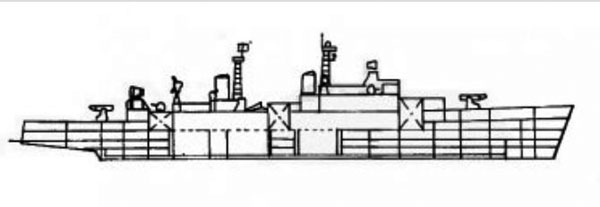
January 1955 proposal for a cruiser design

January 1955 proposal for a cruiser design
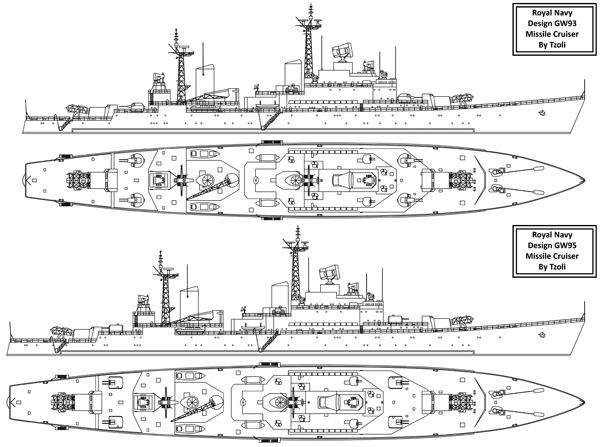
Hybrid cruiser designs GW93/95 by Tzoli
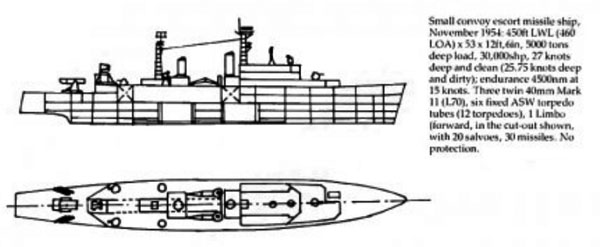
Small convoy escort destroyer proposal, November 1954
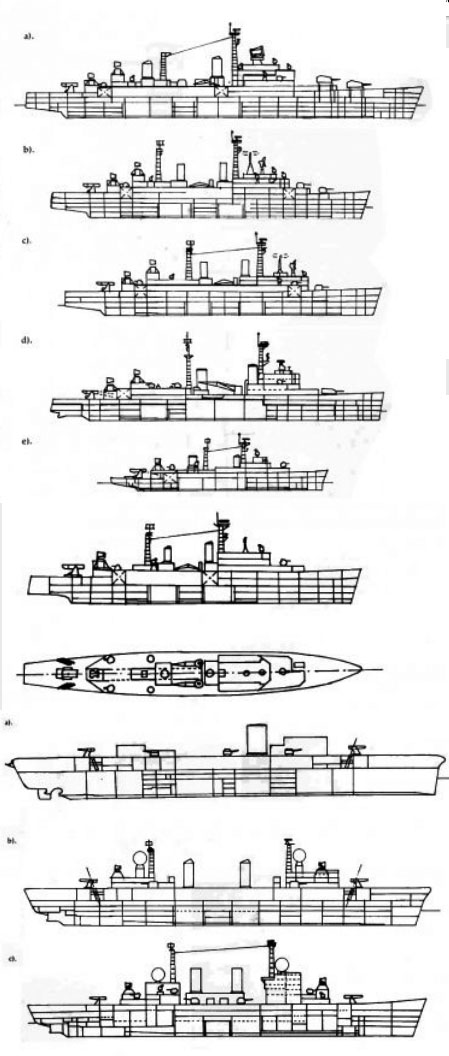
Various designs submitted to the admiralty in 1950-55

GWS 24 design
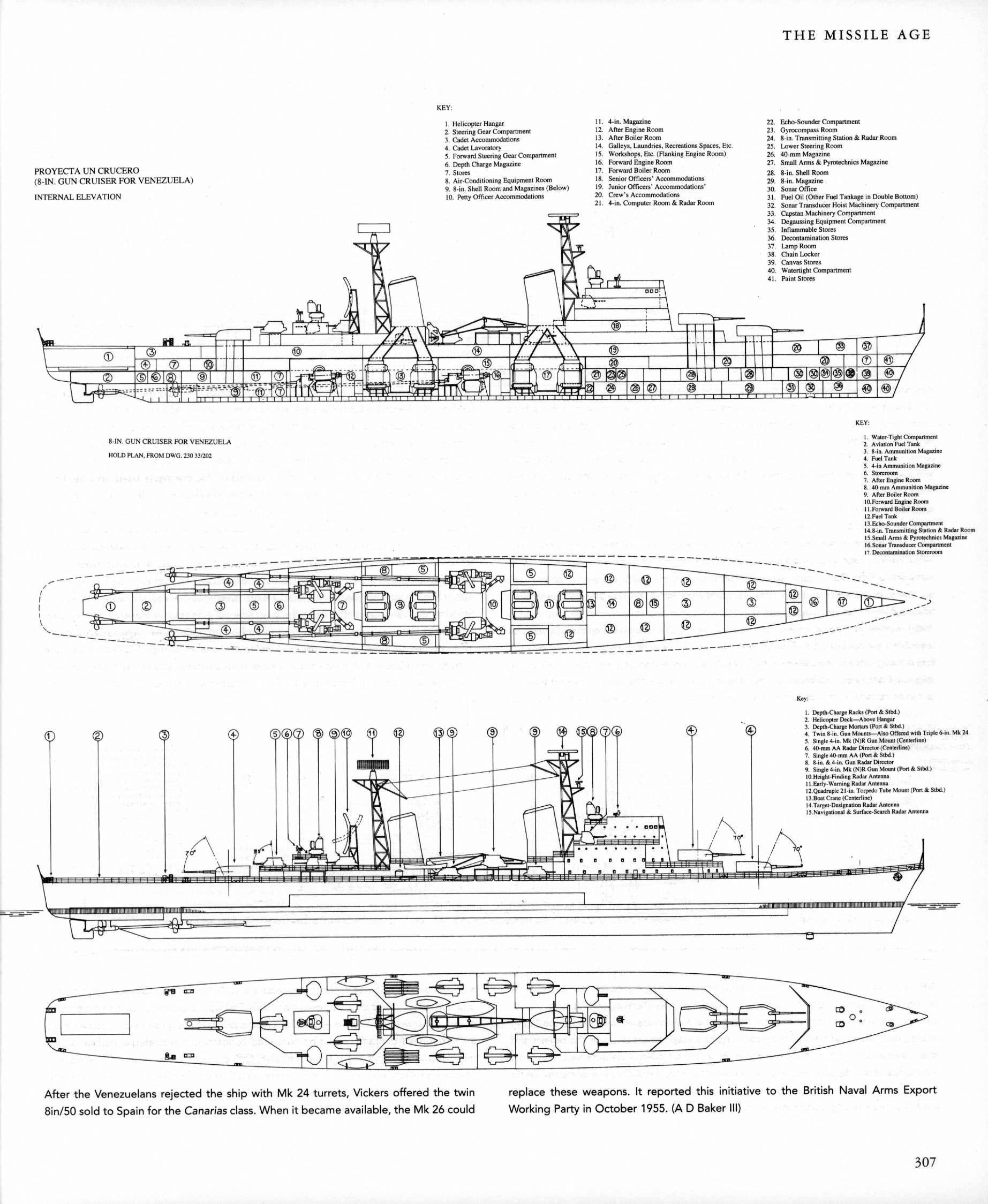
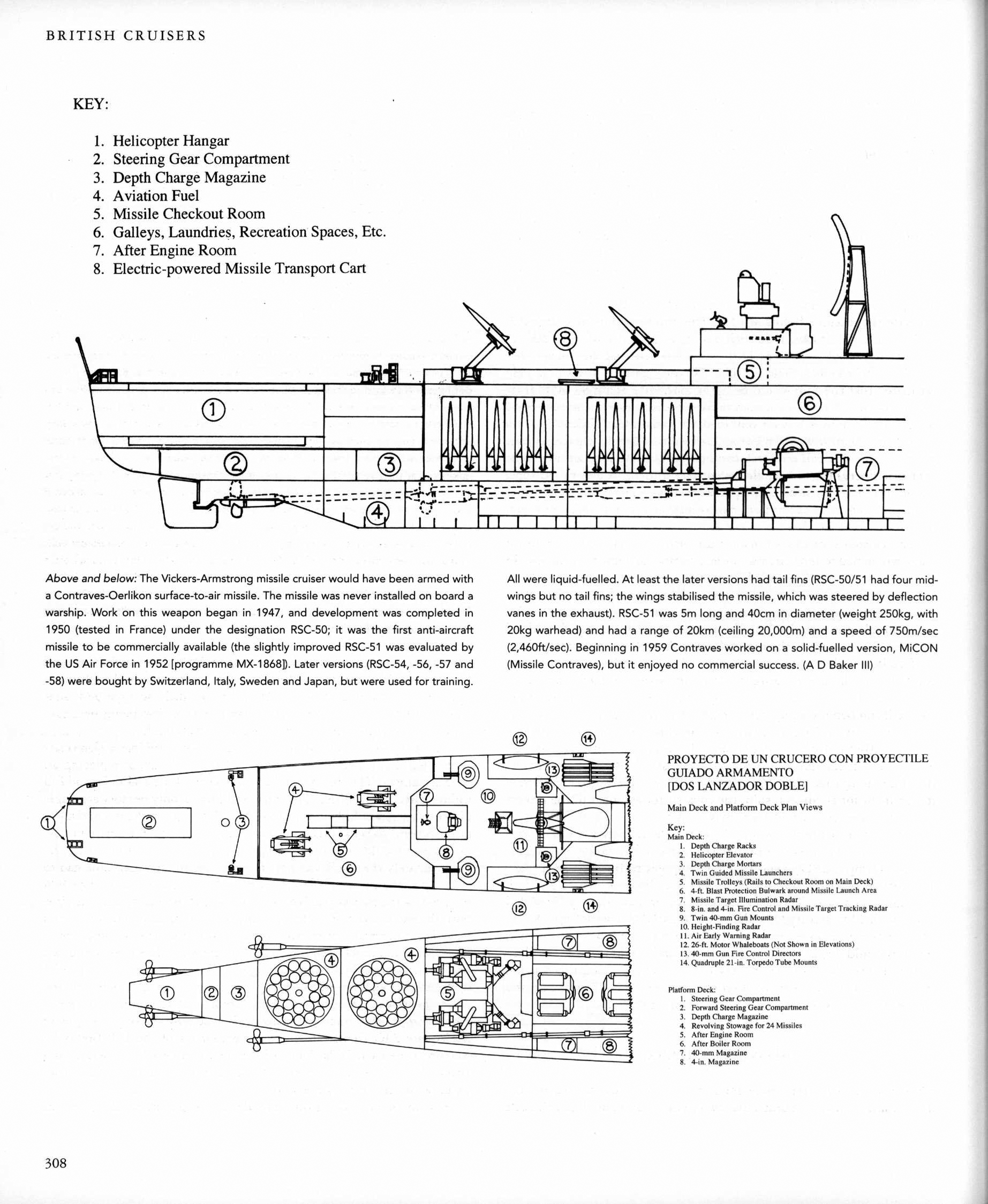 Left: Venezuela British missile cruiser project. Captions from “The Post War Revolution in Naval Warfare”
Left: Venezuela British missile cruiser project. Captions from “The Post War Revolution in Naval Warfare”
Construction would ask for medium tensile steel, and a 505 ft (154 m) long hull. It was tailored to fit 18 Seaslug plus 4 special (nuclear) warhead, the Seaslug being developed as a universal vector also able to perform anti-missile and anti-ship missions. Still, twin Mk 5 Bofors 40mm were kept as an interim while waiting for the “Green Light” (Seacat) missile system still under development. For ASW warfare, a Limbo mortar was chosen. The armament answered on paper all threats and the ship had good potential for upgrade due to its large hull as well as speed and range.
In March 1958 the design was revised again: In addition to the Seaslug, Seacat missiles were added, as well as a telescopic hangar for an helicopter. Mountbatten then tried to convince staff and politicians of the new missile destroyr concept by staged an impressive demonstration, firing ten Seaslugs from HMS Girdle Ness, notably shooting down two piston-engine Fairey Firefly radio-controlled drones. This success apare,tly also pushed the MoD Duncan Sandys, to gain production approval from the Cabinet Defence Committee for the Seaslug. While the test was impressive, there were still many issues to overcome, notably the beam guidance system subjected to bad weather. This forced engineers to add eight fixed stabilisers to the design. Internally, the Seaslug still suffered from a reputation of unreliability and inaccuracy, as shown later in Woomera, shich dissuaded Royal Australian Navy officers to purchase it. Only tireless efforts and faith in it had Mountbatten convince everybody the Seaslug was the only viable solution for the County-class.
By late 1958, new revisions led to the adoption of a high flush deck from B turret and cancellation of the nuclear warhead program for the Seaslug, which was also given folding fins for extra storage of 20 more. They were considered as unready reloads and needed some setup. Although the staff argued against it, Mountbatten also pushed for the adoption of a tight fitting fixed side-hangar. It was to house by all weather the ASW helicopter Westland Wessex. Under US influence, the County class denomination became DDGs, the name “escort destroyer” judged less offensive to gain Treasury and political support. In the medias, cruisers now passed for colonial relics. The Royal Navy staff however still seen the County class as cruisers in disguide due to her displacement, some even hoping to retrofit classic artillery if the new missile system was to fail. Soon the name “County”, which still had fond rememberence from nay veterans, was chosen. Staff accommodation was very “cruiser-like”, and there was a dated and short ranged semi automatic, 4.5 inches artillery, plus additional spotting radar. Extra light Bofors and Oerlikons AA guns could be still fitted in wartime if need be (it was the case during the flakland war in 1982). Doubts about the Seaslug were brushed aside in the end, before the ships were operational, proving efficient against jet Gloster Meteor UC15 drones.
❏ Cutaway | ❏ Another Cutaway (Glamorgan)
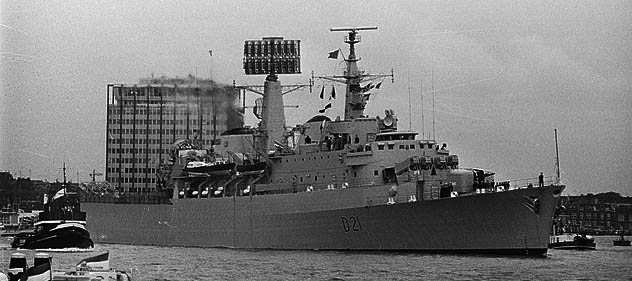
HMS Norfolk in Amsterdam, 1970s
Design of of the County class

DN SN 97
The nuclear question
The County class’s raison d’être was its GWS1 Seaslug. They were however seen as interim solutions pending the new new Sea Dart SAM faster and more accurate but not fitted with a nuclear warhead. It was doubted by First Lord Mountbatten already, which he voiced in 1962 due to escalation theories. The Partial Nuclear Test Ban Treaty in 1963 solved the matter. Carrying nuclear warheads on confined destroyers was already an issue, and crews concerns leading as early as 1952 Air Chief Marshal John Slessor to argue his case to PM. W. Churchill in excluding the Navy from nuclear strike. The 1956 Suez operation’s conclusion and British hydrogen bomb tests in 1954-57 however changed British approach to nuclear deterrence and missile submarines were designated for the navy as main carriers, not surface ships. Large cutbacks were made in destroyer and carrier programmes while the RN designated the Blackburn Buccaneer S.1/S.2 as its default nuclear strike aircraft to deter regional powers. Overall, the ship was much larger than any previous destroyers, with two funnels and far apart masts. Its approach was classic with two forward main turrets, one superfiring.
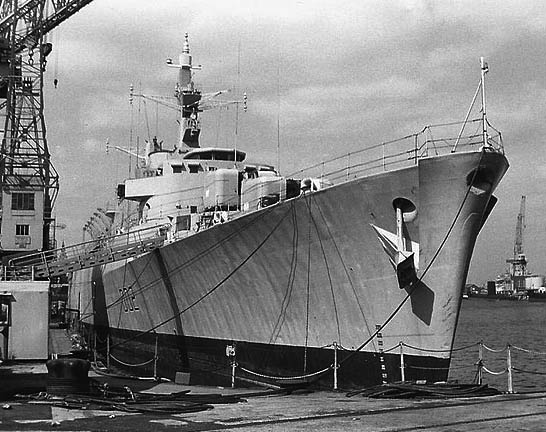
HMS Devonshire in construction, 1961
Protection
The design also included a first attempt of NBC protection and all superstructures were designed to protect the crew from nuclear fallout. The operation rooms were located 5 decks below deep into the ship, to the point it communicated by lift to the bridge, and contained some duplicated command systems. This was the 1960s equivalent to the WW2 conning tower, unarmoured, and counting on a “layered” defense. The Sea Slug itself although for some “already obsolete” in 1957 led to many compromises in the ship design. Its magazine was for example highly vulnerable as well as its missile fuel tanks. However for this, an automatic sprinkler system was in place.
Hull and general characteristics
Powerplant
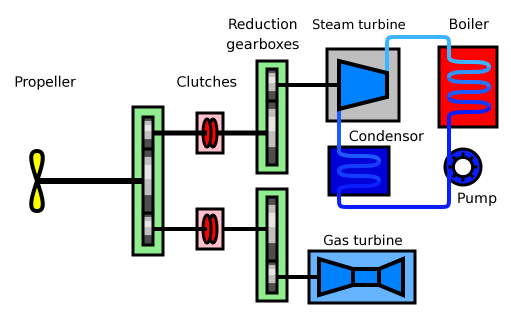
These larges vessels could have been built with conventional steam turbines but the need for long range and flexibility brought out new propulsion schemes. CODOG and COSOG concepts were already in discussions before WW2, but it’s only in the 1950s that this gained traction. In 1958, Combined steam and gas or COSAG seemed a good compromises before CODOG, some shortcomings were still apparent. On the County, there were two shafts propellers, connected to two transmissions geared by two Metrovick G6 gas turbines each (so four total), for a combined 30,000 shp. Each shaft was also powered by a single set of two geared steam turbines fed by one Babcock & Wilcox boiler which claimed another 30,000 shp (22,000 kW). In all, the County had more flexibility with quick-fired gas turbines which allowed the ship to still be fully operational when anchored, only using classic steam turbines for long cruisers ad speed, and a grand total of abour 60,000 shp. This combination of steam turbines and gas turbines using gearbox and clutches allowed efficient cruising, reliability and rapid acceleration in addition to start-up time and was first-generation also used on the Tribal-class frigate. This allowed the County class a contracted speed of 30 knots (56 km/h; 35 mph) combined with a range of 3,500 nautical miles (6,500 km; 4,000 mi).
Armament
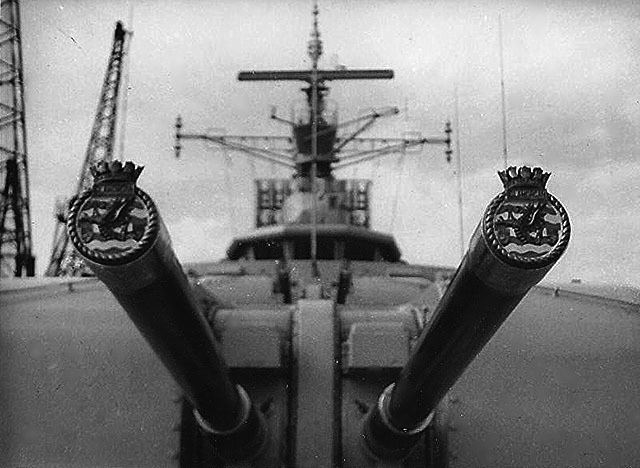
Outside the Seaslug, normally universal missile used primarily as SAMs and antiship to create the long range bubble around the ship, the design still relied on classic artillery with a dual purpose 4.5 in, and trusted Bofors for close range as well as heavy duty torpedoes to deal with closer targets. ASW protection was to be procured by one multirole Wessex helicopter.
4.5-in Mark N6
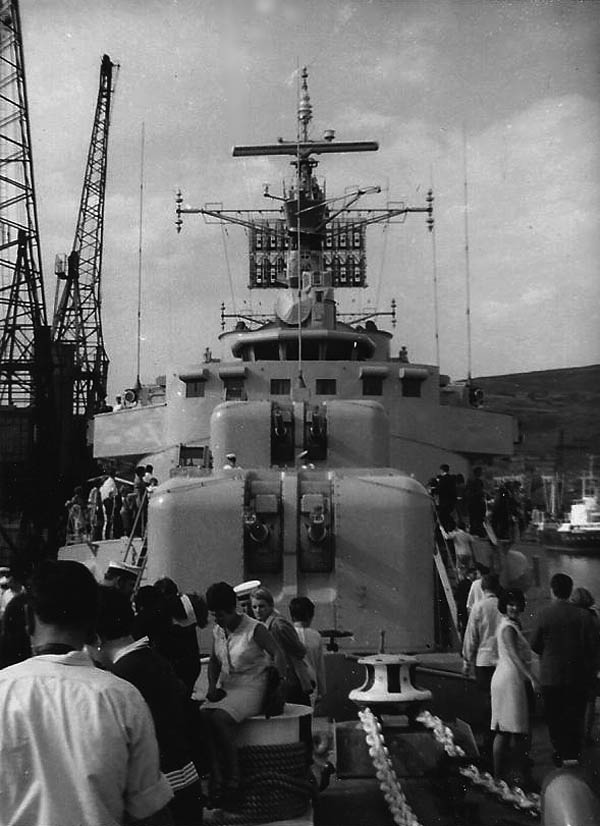
The The QF 4.5 inch gun was the standard medium calibre naval gun of the Royal Navy during WW2, designed as the basic dual-purpose, QF which development started in 1938. This led to a whole family of 45-calibre used up to the 1970s. The QF Mk I has an actual calibre of 4.45 inches (113 mm), and the version used by the new destroyers was the Mark N6, or QF Mark V using the twin mounting UD Mark VI, later renamed gun Mark 6. It became quite widespread, used also by the Battle-class destroyers and “Australian Battle” classes, Daring class DDs and the Type 12 Whitby-class, Rothesay, Leander, Van Speijk, River, Condell, Leopard and Salisbury-class frigates.
Derived from the Mark V, it was designed from the outset for anti-aircraft use. It was given a remote power control (RPC, guns automatically trained and elevate towards the target as enslaved to the director) plus the highest rate-of-fire because it was assisted by automatic ramming. The mounting UD Mark VI had separate high-angle and low-angle hoists for two ammunition types, the AA and SAP/HE plus a third for cartridges. The rate of fire of the Mk V went up to 24 rounds per minute when power-loaded. It used a vertical sliding bloc for quick reload, semi-automatic, above 24 RPM recorded, power-loaded, 14 human loaded, 18 in burst mode, on the Mk VI UD mount, and a muzzle velocity beyond 2,449 ft/s (746 m/s), max range of 20,750 yd (18,970 m) at 2,449 ft/s (746 m/s) and a 41,000 ft (12,500 m) ceiling. The mount allowed a +80° elevation.
Seaslug GWS SAM
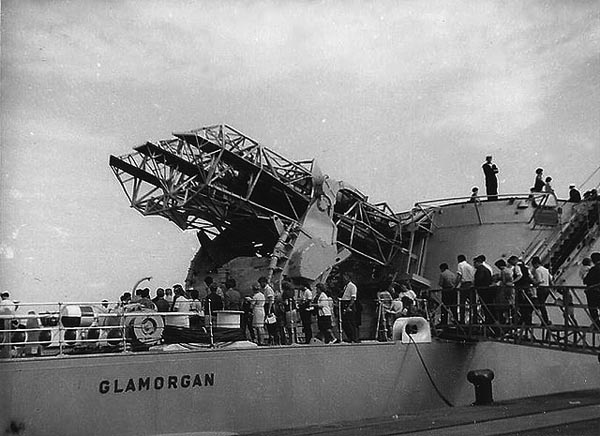
Seaslug ramp and reloading system in 1972.
The Sea Slug was 1st gen, beam riding anti-aircraft missile system designed to hit high altitude fast flying targets such as Soviet nuclear-armed bombers but also track and deter Tupolev Tu-16 “Badger” and Tu-95 “Bear”. They were also intended to deal with other missile destroyers and cruise missile-armed submarines as “universal” weapons. SAM role came first as it was found more challenging to hit a target evolcing at 572 mph (921 km/h) up to 7.5 miles (40,000 ft; 12,100 m).
The Mark 1 barely managed to reach these requirements, but the improved Mk2 reached an extra 10,000 ft (3,000m) at greater speed. To launch these, a large weapon system occupied most of the aft part of the ships. Each missile by itself measured 6 m (19 ft 8 in) long for two tons, with equally large handling arrangements and electronics. This was a challenge for engineers to cram all this and 30+ spare missile in a County hull, even though it was rather large. The solution found was to have the missiles stowed horizontally in a long unarmoured magazine above the waterline (causing some vulnerability issues). To have more carried, on the last batch, it was decided to store some disassembled in the forward end of the magazine. This did not meant lowing the firing rate since others “ready missiles” could be fired when it would have been decided to assemle them as future reloads. 30 missiles left a margin.
The limitations of the beam riding guidance method however, plus no homing head however affected the Mark 2 too and conducted experts that adoption nuclear warhead would largely compensate for the lack of accuacy at first. However nuclea warheaded needed an extra dedicated crew member plus extra space and extra security in a rather busy hull already, and the whole program was cancelled in June 1962 notably over naval budget concerns British limitations in tactical nuclear warheads.

Seaslug Mark 1 (*: Mk.2) |
|
| Dimensions | 6 x 0.42 m (*6.1 x 0.41) |
| Weight | 2,080 kg (*2,834) |
| Propulsion | 4 solid fuel jettisoned boosters & solid fuel sustainer |
| Top speed | 685 mph or 1,102 km/h (*1,370 mph/2,200 km/h) |
| Range/Ceiling | 30,000 yds/55,000 fts (*35,000/65,000 fts) |
| Warhead | 200 lb (91 kg) blast (*rods warhead) |
| Guidance | Beam riding, ship controlled |
Seacat GWS-22 SAM
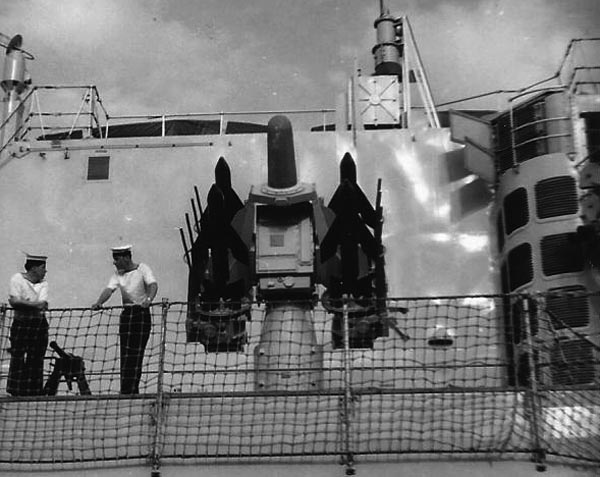
Seacat system onboard HMS Glamorgan
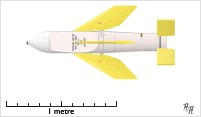 The Seacat was a short-range surface-to-air missile designed by Short and in service in 1962, so County class ships in construction could be completed by two systems installed on the broadside, each with four missiles. They were light enough to be reloaded by hand. Contrary to the Sea slug they enjoyed a considerable export success.
The Seacat was a short-range surface-to-air missile designed by Short and in service in 1962, so County class ships in construction could be completed by two systems installed on the broadside, each with four missiles. They were light enough to be reloaded by hand. Contrary to the Sea slug they enjoyed a considerable export success.
Seacat Mark 1 |
|
| Dimensions | 1.48 x 0.22 m (58 x 8.7 in) |
| Weight | 68 kg (150 Ib) |
| Propulsion | 2 stage motor |
| Top speed | Mach 0.8 |
| Range/Ceiling | 500-1,000 m (1,600-16,400 ft) |
| Warhead | 18 ks (40 lb) continuous rods warhead, fuse pr. |
| Guidance | CLOS, radio link |
Torpedo Tubes

Classic 21 inches (533 mm) either the old dependable Mark 8 Mod 4, last iteration of a 1925 design, absolute standard of WW2, carrying 805 lbs. (365 kg) Torpex at 5,000 yds and 45 knots, or the Mark 12 (Ferry) with its HTP engine (60 knots), and more likely the Mark 20 E (Bidder) of 1955 when entering service. The latter was battery-powered and weighted 1,810 lbs. (821 kg), 254.5 in (6.464 m) long and carrying 196 lbs. (89 kg) at 12,000 yards (11,000 m) and 20 knots. The Mark 21 (Pentane) was cancelled as the wire-guided Mk.22.
The ships should have been upgraded with the Mark 24 Tigerfish in the 1980s, but immediately after the Falklands War, two out of five Mod 1 fired at a target hulk failed due to batteries issues and the others due to accuracy, so the Mark 8 was maintained during that war, notably sinking the ARA General Belgrano. Only by the time the ship were decommissioned, the torpedo was considered operational.
Wessex HAS Mk 3 helicopter
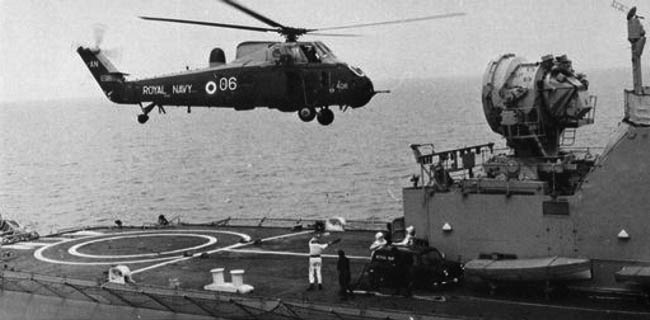
Although this model will be treated in detail in a future post, this licence-built turbine-powered Sikorsky H-34 was a dependable beast of burden qualified for SAR, missile datalink, and ASW warfare.
Electronics
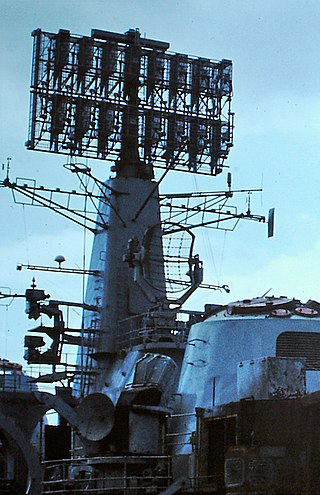
This operations room had its operators monitoring the main radar, the sonar via warfare screens, a full electronc management systel to also deal in deal time with communication and computer links. The electronics specifically dedicated for the Sea Slug comprised a large Type 901 fire-control radar and the Type 965 air-search radar. They were relatively heavy and needed to be placed high up and as such affected ship layout. The better 984 3D radar was rejected only because it was even heavier and and needed to drop a twin turret forward, curtailing gunfire support to deal with surface vessels.
The Action Data Automation Weapon System (ADAWS) was devised to deal with initial problems with the sea slug, and it was tested on HMS Norfolk in 1970.
The failed Australian order, US missiles and British construction
In 1960 as US missiles were seen as superior at the time compared to the Seaslug, the Royal Australian Navy (RAN) wanted for its fleet a County-class, but armed with the Tartar missile plus more hangar space for three Westland Wessex helicopters and full steam propulsion system. In the end, after studies has been made, the Australian government changed it smind and ordered the US-built Perth class (Charles F. Adams variant). Among argumets to drop negociations was that redesign a steam-propelled variant of the county would be opposed whereas the cost of the redesign for the Tartar missile would have been too much. Reminsiscent of more recent endeavours ?
The Terrier was also not excluded in UK either and had some in the RN that argued to built a licenced version instead of the Sea Slug, and it was even considered for the second batch. But it was chosen otherwise to project the latest innovations of the British missile and aerospace industry and adopt instead the much awaited Sea Dart…
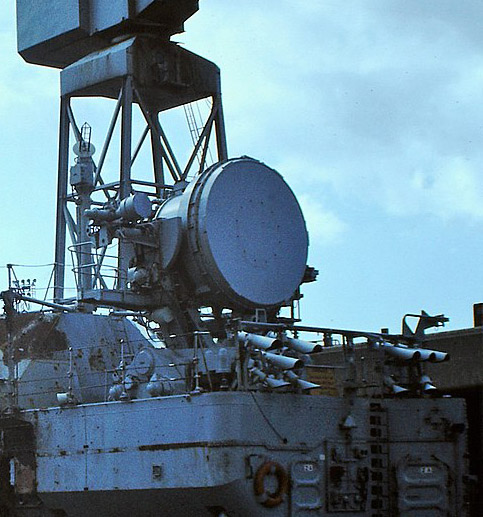
Modifications and modernization (1966-78)
The second batch of four County class vessels (Antrim, Fife, Glamorgan and Norfolk) were given an improved air warning and target indicator 965M radar called “double bedstead” plus a revised 992 radar for close range tracking in addition to surface warning. It acted as sea-skimming missile detectors. The Seaslug Mk2 replaced the Mark1, and capable of hitting targets up to 30 km. ADWAS command and control system now was greatly enhanced, able to combine data from the 965 and 992 radars and link with similar systems on other RN warships. It became vital as those installed (Type 984 3D processing systems) onboard the HMS Victorious, Hermes and Eagle, were removed and this affected the first batch greatly. So the Batch 2 vessels were now independent in firing and guiding their seaslug missiles.
The initial pair of twin QF 4.5-inch turrets forwards had magazines carrying 225 shells and it was still less than the Leander-class frigates with their single turret. Batch 2 did not improved on this point but instead removed ‘B’ turrets in the late 1970s to make room for four single MM38 Exocet surface-to-surface anti-ship-missile canisters, making the County-class the first and only Royal Navy warships with three missile systems. The Exocet had the advantage of a “fire and forget” approach and did not need much in terms of ship’s guidance. Until the 1970s the ships were quite unique in the Royal Navy, bearing their original designation of DLGS, derived from the American Treasury term of ‘Destroyer Leader, Guided Missile’, applied to the new generation of big US and British fleet escorts. In 1972–73 currency the ship’s cost was estimated £500,000 and their average annual maintenance cost was in 1981–82 worth £7.0 million.
Assessment of the County class in combat (1982)
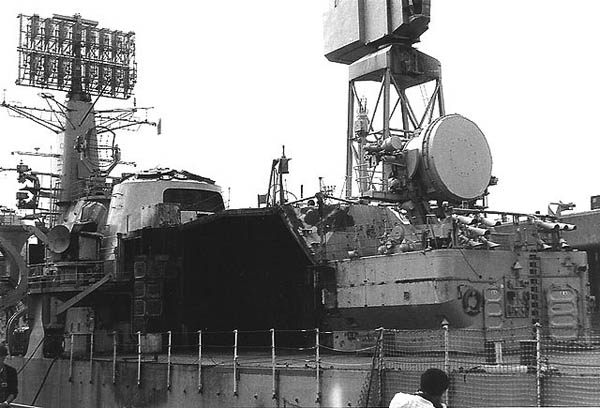
Battle damage on HMS Glamorgan in the flaklands
In the mid-1960s the County-class destroyers were considerable assets for the RN, with an undeniably impressive appearance, modern data links feeding the Type 984 radar. They projected an effective detterent during the Indonesia–Malaysia confrontation and the Mark 1 Seaslug was reasnably reliable in operationally, proving later a good target for the new Sea Dart missiles in the late 1970s. The Mark 2, which was supersonic still however has issues, notably related to the possible breakup when the boosters separated. Inaccuracy was still there on the Mark 1 in the 1970s, with a primitive beam-riding guidance, lack of infrared homing, lack of proximity fuze. By all means, this limited the County class overall operational value. However with the adoption of short-range air defence GWS-22 Seacat system, the County class became the first Royal Navy warships with two guided missile system, even three systems when the Exocet was adopted in 1980.
Apart the tour of duty and a few rounds fired during the Indonesia–Malaysia conflict, the only serious combat test of the class came with the Falklands War in March 1982.
HMS Glamorgan was the only one hit by an exocet missile. Lessons learnt was she has no countermeasures, and her captain decided to brace for impact basically, making a speedy hard turn to try to avoid a direct collision. This partly deflected the missile, which caused less serious destruction than on other ships hit in this war. Still, the fire spreading into the magazines and missile fuel tanks could have been catastrophic. It showed that a ship the size of a County class could survive such impact. Although she was no longer fully operational, in more severe circumstances she could have been deployed on site, largely still offensive.
HMS Antrim show what an helicopter can do, participating in the sinking of the submarine Santa Fe, and first ASW “kill” by helicopter. In San Carlos she was repeteadly attacked by Argentine Skyhawks and took 12 near-misses, one hit, fortunately failing to explode. She was operational under ten hours and back in action firing her Sea Slug on an incoming A-4 Skyhawk, but missing. This did not contributed to the reputation of this weapon system. However no Sea Cat was fired.
The Egyptian order (1977-78)
Consideration for sale of HMS Antrim to Egypt after conversion was issued in 1977. The ships sold would have been converted as helicopter destroyers, modified to carry six Lynx helicopters in the former missile loading space aft. This fell through in 1978, so HMS Antrim went on the disposal list. HMS London had been earmarked also to be fitted with a lighter tubular foremast supporting a Type 992Q radar scanner, and that modification was subsequently to be extended to HMS Antrim, Fife and Glamorgan, scheduled also to receive the Exocet missiles while older ships were refitted with GWS-22 Seacat systems.
Under other flags: Chile and Pakistan
Pakistani Babur (1982)
The 20 years old HMS London was sold on 23 March 1982 to Pakistant, recommissioned as Babur, under Captain Mukhtar Azam. D-84 PNS Babur was in service for another decade, eventually decommissioned in 1993; She was sold for scrap in 1995 and BU afterwards. It is not known if she was modernized in any way. Her last British updgrade was still “fresh”.
Capitán Prat class destroyers (1982)
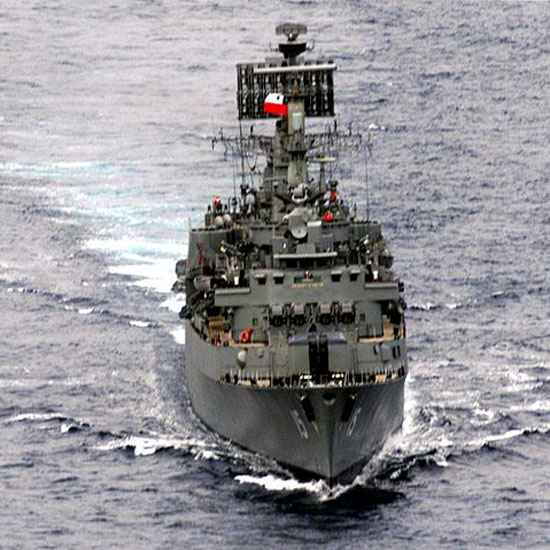
Chilean destroyer Blanco Encalada 1999
In the 1980s, four County class destroyers were sold to Chile, an arch-rival of Argentina: HMS Fife became Blanco Encalada in August 1987, Glamorgan Almirante Latorre in September 1986, Antrim Almirante Cochrane in June 1984 and the lead ship, HMS Norfolk was Sold to Chile as Capitán Prat in April 1982. Here are their story:
– Capitán Pra: She was recommissione din “stock condition” with the latest British upgrades. In 1996, her Sea Cat launchers were replaced by an Israeli Barak SAM. In 2001 also her old her Sea Slug system was removed to make room for a new large hangar as an Helicopter Destroyer, eqipped with up to three multirole Cougar attack helicopters. On 24 February 2006 she was laid up, decommissioned on 11 August 2006 and later scrapped in Mexico.
– Almirante Cochrane: She underwent the same refit as Blanco Encalada, with no Sea Slug, extended aft deck, new helicopter hangar. In 1996 she also received the Barak SAM. She was decommissioned on 7 December 2006 and on 11 December 2010, towed to China for scrap.
– Almirante Latorre was sold on 3 October 1986, renamed and seeing her Sea Slug system retained but reset to only fire on surface targets. She received a single, small MBB Bo 105 helicopter but in September 1995 she was refitted (until August 1996) her 40mm Bofors replaced by two 16-cell launchers (Barak system), and Chilean SISDEF-100 combat system, but after tests and fixes she ws not recommssionned before late 1998. She was decomm. in 2004, sold, and sank on 11 April 2005 while under tow to be broken up.
– Blanco Encalada was refitted at Talcahuano right after her arrival and her Sea Slug was entirely removed, her aft deck was extended while a new and larger hangar was constructed, all work completed in May 1988. In 1996, Blanco Encalada saw also her old Sea Cat launchers removed, received instead an Israeli Barak SAM system. She was decommissioned on 12 December 2003, sold by November 2005, BU in Turkey in 2013.
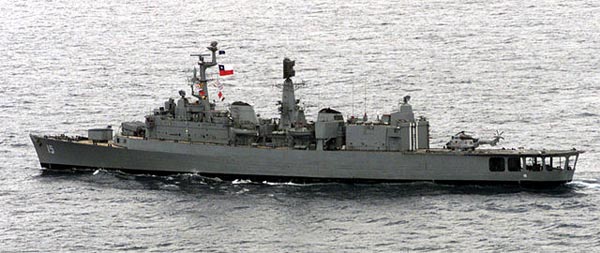
Blanco Encalada (FF-15) at Teamwork South, 1999

Chilean missile DD

As Capitan Prat, D11, in 1991

County (1st batch) specifications |
|
| Dimensions | 158.54 x 16 x 6.4 m (520.16 x 54 x 21 ft) |
| Displacement | 6,200t; 6,900 t FL |
| Crew | 471 (33 officers, 438 ratings) |
| Propulsion | COSAG two B&W boilers, GS turbines, 30,000 shp |
| Speed | 30 Noeuds (56 km/h; 35 mph) |
| Range | 3,500 nautical miles @10 knots |
| Armament | 2×2 4.5-in, 2x 20mm AA, Seaslug SAM (24), 2×6 Seacat, 2×3 21-in TTs |
| Aircraft | Wessex HAS Mk 3 helicopter + facilities |
Links/Sources
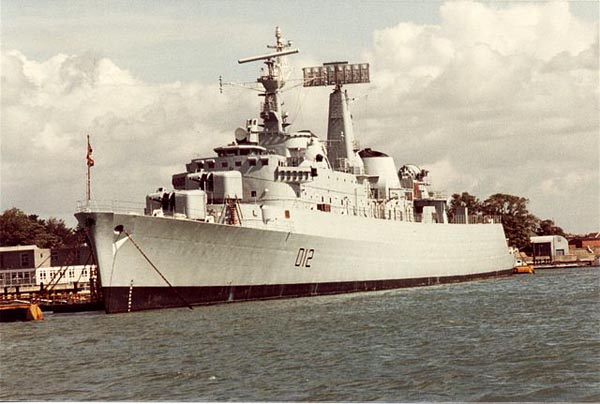
Books
Specs Conway’s all the world fighting ships 1947-1991.
Colledge, J. J.; Warlow, Ben (2006) [1969]. Ships of the Royal Navy: The Complete Record – Chatham Publishing.
Marriott, Leo, 1989. Royal Navy Destroyers since 1945, Ian Allan Ltd.
McCart, Neil, 2014. County Class Guided Missile Destroyers, Maritime Books.
Brown, D. K.; Moore, G. (2003). Rebuilding the Royal Navy: Warship Design Since 1945. Chatham
Friedman, N. (2006). British Destroyers and Frigates: The Second World War and After. Chatham
Hall, N. (May 2008). “County Class Missile Destroyers”. Ships Monthly.
Hall, N. (December 2008). “County Class Missile Destroyers, HMS London role in Confrontation and Aden crisis as HMS Eagle escort 65-7”. Ships Monthly
Marland, P. (2016). “Postwar AIO & Command Systems in the Royal Navy”. In Jordan, John (ed.). Warship 2016. Conway
Marriott, Leo (1989). Royal Navy Destroyers Since 1945. Shepperton, Ian Allan.
Moore, G. (2005). “From Daring to Devonshire”. In Jordan, John (ed.). Warship 2005. Conway
Lord Earl Mountbatten (1989). Ziegler, Philip (ed.). From Shore to Shore: The Final Years. The Tour Diaries of Earl Mountbatten of Burma, 1953–1979. Collins.
Preston, A. (1980). Warships of the World. Jane’s.
Purvis, M.K., ‘Post War RN Frigate and Guided Missile Destroyer Design 1944-1969’, Transactions, Royal Institution of Naval Architects (RINA), 1974
Wise, Jon (2007). “Girdle Ness: Seaslug Missile Trials”. In Jordan, John (ed.). Warship 2007. Conway
Wilson, Ben (2013). Empire of the Deep. London: Weidenfeld & Nicolson.
Seldon, A. (1981), Churchill Indian Summer. Conservative Government 1951-5, Hodder & Stoughton
Grove, E. (2005), “The RN Guided Missile”, in Harding, R. (ed.), Royal Navy 1930–2000. Innovation and Defence
British Guided Missile Destroyers: County-class, Type 82, Type 42 and Type 45 (New Vanguard)
Links
countyclassdestroyers.co.uk
seaforces.org
countyclassdestroyers.co.uk
Association
globalsecurity.org
Ships logs
hazegray.org
ukdefenceforum.net
battleships-cruisers.co.uk
historyofwar.org
commsmuseum.co.uk
worldnavalships.com
IWM Photos coll.
GW series postwar cruisers secretprojects.co.uk
about cruisers concepts secretprojects.co.uk
secretprojects.co.uk
about the class (wiki)
about the seaslug
M-Ops-Events1961-70
Videos
Brief about the class
Brit. Pathé HMS Glamorgan – Computer Ship Of The Future (1967)
About the seacat
The models corner
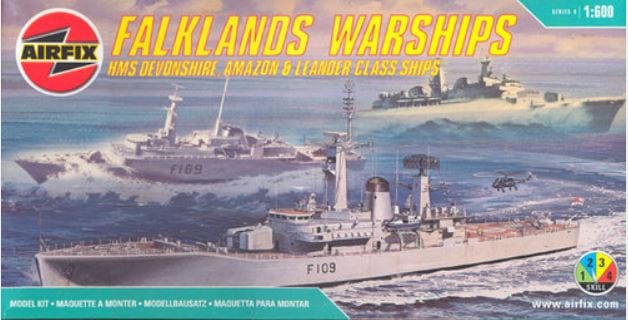
3D model shapeways Decapod 1:600 batch 2
On scalemates: All references
Detailed plans on fleetscale.com
Fleetscale 1:72 hull (fiberglass)
The County class service records
While lacking the spares of a traditional cruiser, the Director of Naval Construction wrote them as usable in the cruiser role with just enough space for Flag staff offices and the admiral’s barge accommodation. During their first decade of service nonetheless, these modern guided-missile destroyers, quasi-cruisers with big missiles gave the Royal Navy sufficient deterrent to quell insurrections by their sole presence in Indonesia, Malaysia and Borneo. Apart of course the Falklands, where three participated in 1982, the next decade was quieter, but with a soviet threat still going high. They did not saw the end of the cold war, but missile tech aged far faster than gunnery. They were just too big as destroyers and the format of the next vessel was much reduced, with the notable exception: HMS Bristol, RN’s white elephant of the 1970s.
HMS Devonshire 1962-1984

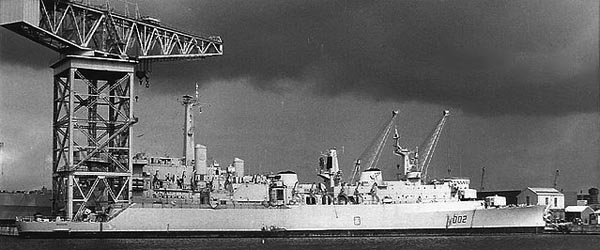
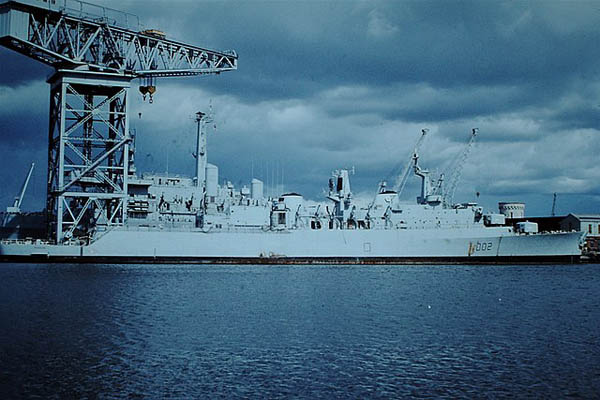
HMS Devonshire, Fitting out in 1962
In 1962 Devonshire was commissioned as the first of the class, soon to become the first RN ship to fire a Seaslug missile (outside the test ship). Her first long range operation was in the Mediterranean, and back to Portsmouth. She also sailed that year for Bermuda and the US east coast, and back to Portsmouth for the new year. Captain George Cunningham Leslie OBE took command of the ship, from 1965 to 1966. On 31 August that year she collided with the tanker British Sovereign, off the mouth River Elbe mouth, there was some damage but no injuries. Captain Peter Buchanan took command in 1973, until 1974 when she was patrolling the Persian Gulf and Caribbean Sea. She was present at the 1977 Silver Jubilee Fleet Review off Spithead, representing the First Flotilla. Budget cuts that year meant she was not upgraded like the Batch 2 and drastic budget cuts by the new gorvernment meant she was scheduled for decommission sooner than expected, in 1978. There was an opportunity of sale to Egypt but it did not go through. For six years she was mothballed in Portsmouth ad towards the end, used as a target for the Sea Eagle anti-ship missile. She was sunk for good by HMS Splendid on 17 July 1984 in the North Atlantic, by a single Mark 24 Mod 2 Tigerfish torpedo.
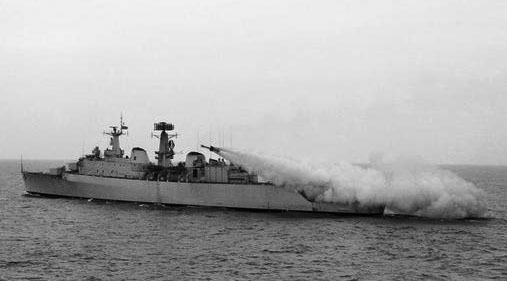
HMS Devonshire firing her sea slug in 1962
HMS Hampshire 1963-1979
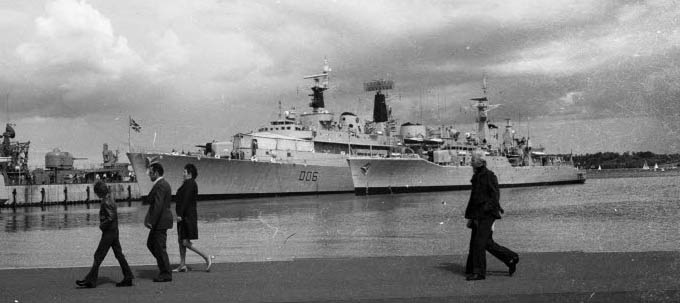
HMS Hampshire at Kiel week 1974
HMS Hampshire was commissioned on 15 March 1963, second ship of the first batch, with Captain Robert White RN in command fro the start of her completion to 1964. She was the cheaper County class ever built, valued at £12,625,000 for her construction cost. From her third Commission in 1967 she became flagship for the Western Fleet (United Kingdom). In July 1969 (Captain R A Trowbridge) she was present at Torbay, for the Royal Review and presentation of a new colour to the Western Fleet (United Kingdom). In 1969-72 Captain R P Clayton too command but she was soon placed in refit. Plans to upgrade HMS Hampshire and her sister ships with Seaslug Mk 2 and a the new digital combat system being of Batch 2 was cancelled for Hampshire and Devonshire, on 31 March 1967 because of the decommission time for the fleet was judged too great. The remaining two upgrades were cancelled as well in 1968. She was nevertheless in refit in 1970-1973 and recommissioned under Captain I F Beeson RN (until 1975) and Captain Michael C Henry until 1976 with no notable event. In 1976, she was the first of the County-class decommissioned. Decision was made by the Labour Government making drastic budget cuts, under pressure from the International Monetary Fund. By that time she barely had 12 years of service. She was cannibalised for spares, allowing her sister ships to live longer and when this was done, she was sold for scrap in 1979 and broken up by Thos W Ward, at Briton Ferry.
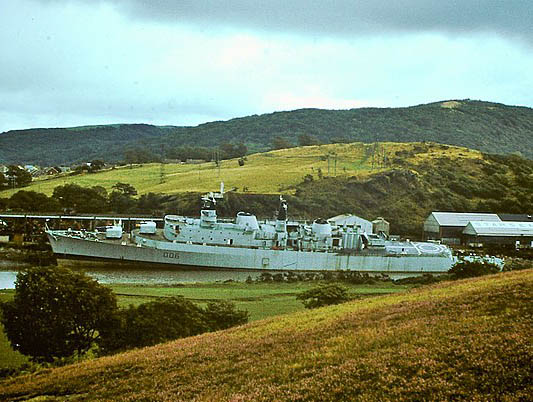
HMS Hampshire scrapped at Wards Scrapyard, Briton Ferry, 1979
HMS Kent 1963-1998
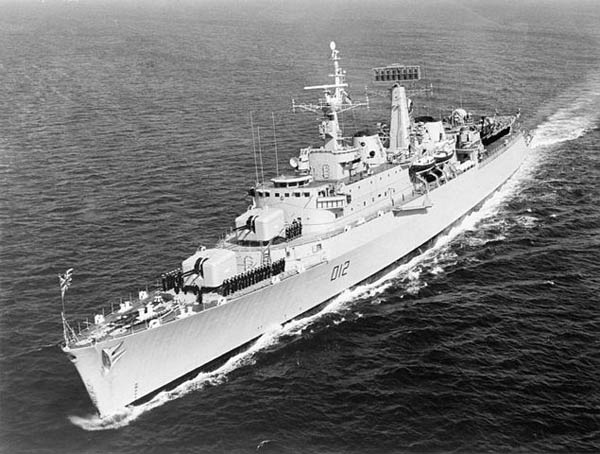
Kent as completed 1963
Commissioned in 1963, HMS Kent was affected as an escort for the British aircraft carrier fleet. She sailed with HMS Victorious, Eagle, Hermes in the Atlantic but also the Indian, and Pacific Oceans. She notably hosted negociations for the Withdrawal in Gibraltar, suffered a fire during a refit in 1976 and assisted to the Silver Jubilee fleet review of 1977. As upgrades were cancelled in 1967–68 she received some batch-2 improvements, notably an upgrade to the GWS22 Seacat system, Type 992Q target indicator radar. She returned in operations by December 1972 until decommissioned in the summer of 1980 (17 years of service).
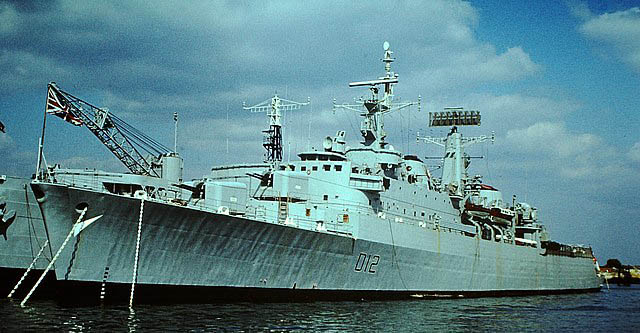
Portsmouth Navy Days 1980

Kent in 1982
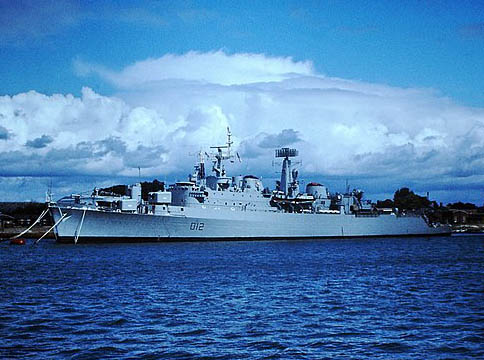
Kent in portsmouth Navy Day 1982
She was tasked as replacement for HMS Fife as Fleet Training Ship in Whale Island, Portsmouth Naval Base. As the Falklands War started it was discussed her possible fully recommission, bit two years of loose maintainance mant a refit which was rejected as it was dubious the war would last long. Until 1984 she was used for artificer and mechanic training with HMS Collingwood and HMS Sultan. In 1984 she became a harbour training ship (Sea Cadet Corps), paid off in 1987, training hulk at Portsmouth, stricken 1993 and mothballed until 1998, sold to Indian shipbreakers.
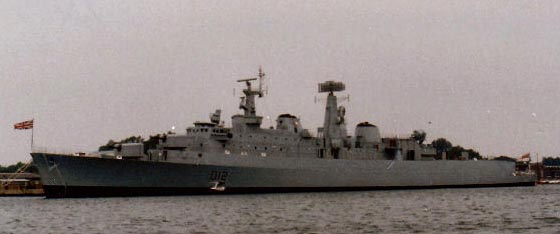
Kent in portsmouth 1987

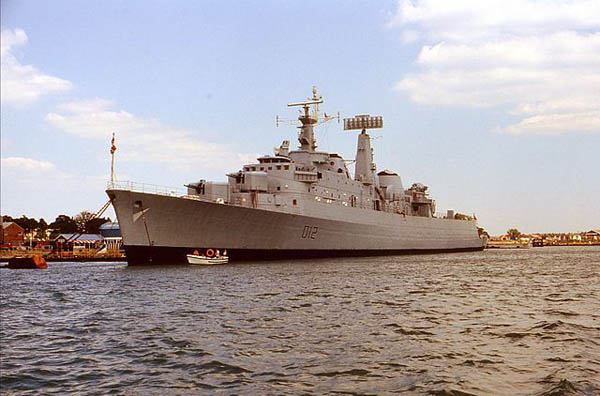
July 1989
HMS London 1963-1982
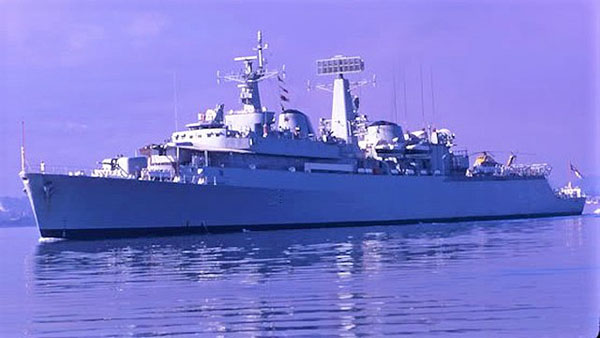
HMS London was commissioned at Swan Hunter’s yard, Wallsend, on 14 November 1963; Her first captain was J.C. Bartosik. The following weeks and months were dedicated to qualify the whole crew with the armaments and electronics. She mde her first live missile fire of her Sea Slug off Aberporth in April 1964. She carried the Duke of Edinburgh when crossing the Atlantic in September 1964, stopping in the Bermuda and Houston, then joined Vice-Admiral Sir Fitzroy Talbot’s squadron making visits of South America and crossing Panama, the pacific coast: Peru, Chile, Uruguay, Brazil and Simonstown where she spent Christmas. Next she sailed to Mauritius, to lease her helicopter to erect a TV mast. She departed for the Far East, stopping in Hong Kong, Bangkok, Subic, Singapore and in Malaya. At that time the fleet presence became a deterrent for President Indonesian Sukarno to intimidate the young Federation of Malaysia. HMS London then headed back home via Aden but stopped to assist the adrift Adrian Augusta in the Red Sea. She stopped in Gibraltar before reaching Portsmouth in time for Navy Days, 1965. The next years were uneventful.
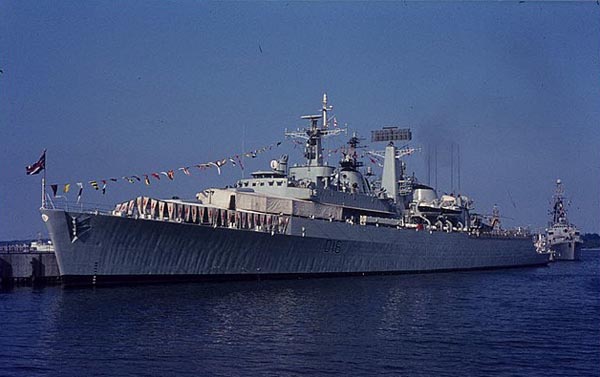
London at the Kiel week, 1972
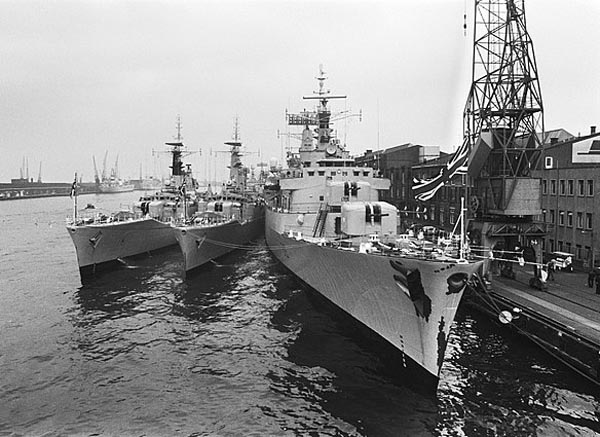
HMS London in Amsterdam, 1977
On Easter Monday 1969, HMS London departed for another cruise, starting with the Far East with Admiral Sir Varyl Begg on board, recently appointment as Governor and C-in-C Gibraltar. She was there on 17 April, then headed for Simonstown, later taking the Beira Patrol, then sailed to Gan and Singapore. Until September she was in the South China Sea (Hong Kong, Manila, Subic Bay, Japan, Singapore). In September, she teamed with HMNZS Otago off New Zealand and visited Auckland and Gisborne for a celebration Captain Cook’s landing. She sailed for Wellington and Lyttleton, crossed the Tasman Sea to Hobart and Melbourne and then two weeks in Sydney. She headed back to Singapore in December. In Januay 1970 she sailed through the Indian Ocean but veered south to the Cape of Good Hope and went into the Atlantic for Sea Slug missile firings with the US Navy. She stopped in St Vincent and Puerto Rico before going back to Portsmouth.
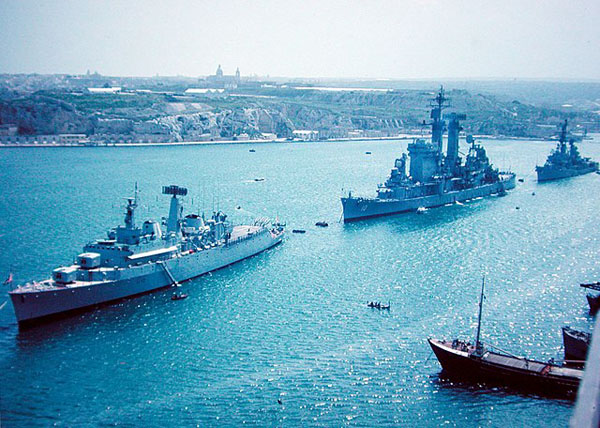
London close to USS Albany and Lawrence in Malta, 1971. A good way to campare her relatively low and elegant profile to the isanely tall and “busy” profile of the rebuilt Albany class. Behind, her equivalent in the USN, a Charles. F. Adams class missile DD.
There ensued drydock maintenance and fixes followed in Portsmouth. By October 1970 she was back at sea, visiting to Greenock and in February 1971 started for another nine-month Mediterranean mission. She stopped in Leghorn, her crew visiting Pisa and Florence, and she also stopped in Civitia Vecchia to visit Rome, Pompeii and Naples, and she stopped in Trieste, the crew visiting Venice. She was in Crete for the 30th anniversary of the WW2 battle then headed for Cyprus and Istanbul, crossed the Black Sea and stopped in Samsun. She was back to Portsmouth in early November 1971. She also made missile firing practice at Aberforth. Years of hoeme waters routine exercizes followed, until London in July 1976 was chosen to represent UK for New York City Indep. Bicentennial celebrations. There, she hosted several diplomatic and social duties but her crew was frequently on leave in NYC also. In 1977, she was back in the Mediterranean, the last ship to leave Malta as the British RN base was closed. She also attended the 1977 Silver Jubilee Fleet Review off Spithead.

London in 1981
1979-81 were uneventful but she became the last RN vessel firing the Mark 1 Sea Slug, spending her last 17 Mk 1 seaslugs on 9 December 1981 to train HMS Cardiff and Glasgows with their Sea Darts, or gunnery practice for HMS Brilliant. She also fired her Seawolf and on 10 December 1981, made a final twin turret broadside. She was decommissioned in late December 1981, her last trip being a West Indies as Belize Guardship duty, seeing the independence to Antigua. She was decomm. but no BUT, sold instead to Pakistan as PNR Babur.
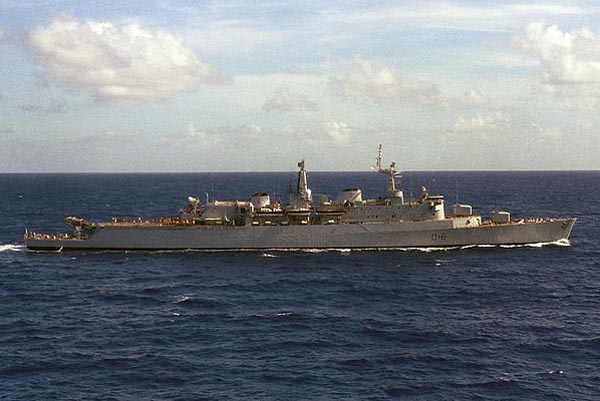
London in 1982, her last operational year
HMS Fife 1966-1987
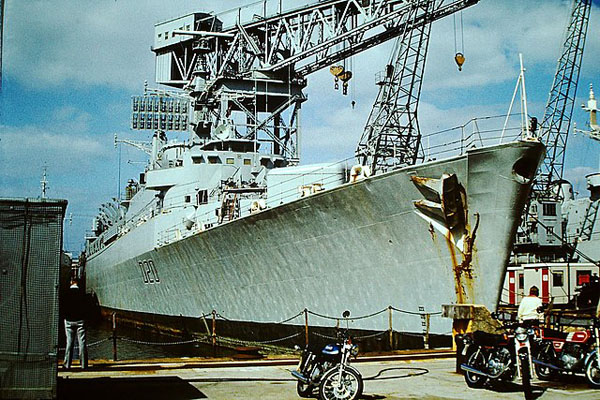
HMS Fife was commissoined in June 1966, under command of Captain Robert H Graham. She took part in a world cruise, in a large group deployment, leaving Portsmouth on 1 April 1970 starting with the Mediterranean and stopping in Safi, Morocco, Lagos, Nigeria, Simonstown in South Africa and briefly took part in the Beira Patrol off Rhodesia after its independence. The naval blockade was part of sanctions inflicted on the regime. While in the Indian Ocean she stopped at the NATO base on Gan on her way to Singapore. For 6 weeks she was immovbilied for her Assisted Maintenance Period (AMP) and departed for the South China Sea and her first live firings. Back home, she was refitted in Portsmouth to carry more missiles.
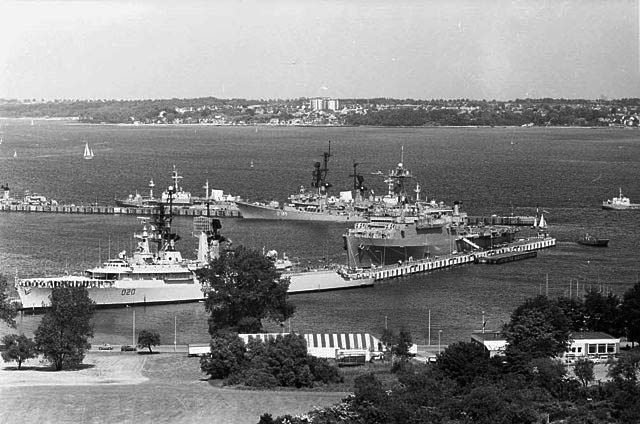
hms fife at Tirpitz Mole, Kiel Week 1972
Fire trials were successful against US targets while in the Philippines, the only failure due to a telemetry beam mutating waveguide and one booster motor failing to disengage. She also stopped in Hong Kong and Kobe for Expo 70, then Pearl Harbor (where the local medias were bemused by the mock burial of rhum, as she was the last RN ship to abolish the traditional rhum issue), Long Beach (California), Acapulco (Mexico), the Panama Canal, Puerto Rico and back to the Mediterranean, stopping in Toulon and Malta, Gibraltar, a long trip for her captain David Scott, ww2 hero captain of HMS Seraph.
During her 1977 maintenance she had her ‘B’ turret removed, replaced by Exocets. The same year she attended the Silver Jubilee Fleet Review in the 2nd Flotilla. In 1979, she assisted the island of Dominica after Hurricane David, later awared for this the Wilkinson Sword of Peace. Refit lasted from October 1980 to December 1982 so she was not in the Falklands. She gained notably a Westland Lynx Helicopter and satellite communication plus modern ASW torpedo tubes. Recomm. on 31 March 1983, she was refitted again in 1986.
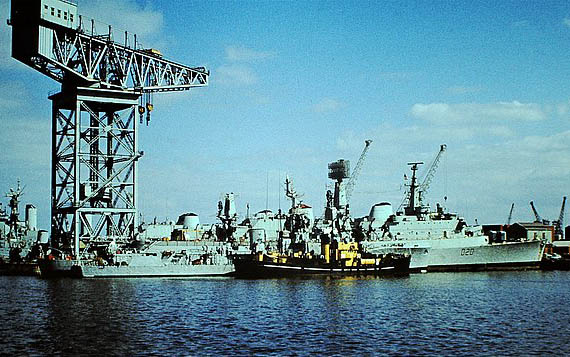
HMS fife in Portsmouth, 1980
Fife she was converted as a mobile training ship, her Seaslug and magazine removed and the free space used for accomodations. By June 1986, she was trialled with her new mess decks and classrooms and in September made a Dartmouth Training Ship (DTS) deployment in the Caribbean Sea and off Florida with the Frigates HMS Diomede and Apollo. During this, she was shadowed and photgraphed by a Russian Kashin-class destroyer. She made her second deployment in January 1987 via Brest, and into the Mediterranean Sea with HMS Intrepid. Her last was off North America with HMS Juno, both sailing into the Great Lakes. By June 1987 she was sailed to Portsmouth to be decommissioned, with almost 30 years of service, the longest of any of these destroyers.
HMS Glamorgan 1966-1986
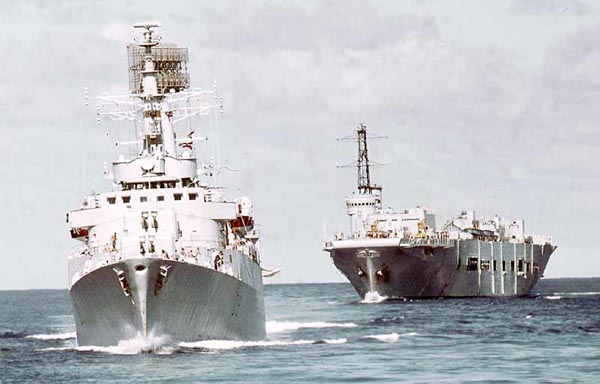
HMS Glamorgan was commissioned on 14 October 1966, as D19, second ship of the second batch (sometimes called Fife class). In October 1968, she took part in Exercise Coral Sands, joint amphibious operations off Queensland, Australia with New Zealand, the RAN, RN and USN. She visited Australian ports and in March 1976, took part in the multi-national exercise Valiant Heritage, simulated amphibious assault against San Diego. She made live-fire Sea slug exercise. But her serious test was in the Falklands:

Glamorgan in 1976
At the start of the campaign on 2 April 1982 she was already mid-way, off Gibraltar and about to start exercises whe she was called upon, immediately diverted to the task force. She became flagship, Rear Admiral Sandy Woodward, of First Flotilla, Commander Carrier Battle Group until 15 April. The flag was transferred to the aircraft carrier HMS Hermes. Her role early on was to shell enemy objectives inland with her 4.5-inch (114 mm) guns and she was even first in action on the evening of 1st May 1982 with the frigates HMS Arrow and HMS Alacrity.
They shelled Argentinian positions around Stanley until three IAI Dagger fighters were spotted incoming, dropping two 500 lb (230 kg) bombs. Two were near-misses for Glamorgan. Two weeks later, on 14 May, she carried and supported a SAS Raid on Pebble Island (west of the Falklands). She was regularly called for shore positions shellings east of the islands notably as a diversion for the main action in San Carlos Water. She also rained death on the airfield at Stanley and on 29 May fired a Seaslug missile at the airstrip, landing close to the radar, proof the primitive beam riding tech could be used to repurpose the missile.
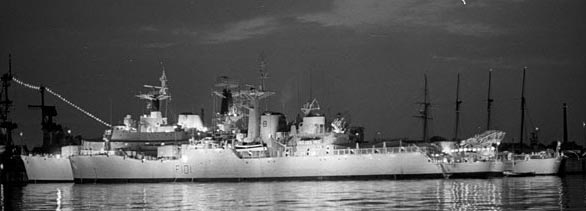
In Kiel week, 1974
By June, the task force was detached to protect the Towing, Repair and Logistics Area (TRALA) area setup 200 miles (320 km) away but was soon recalled in the evening of 11 June as the Royal Marines were engaged in the Battle of Two Sisters. On 12 June 1982 in the early morning HMS Glamorgan was attacked with a single MM38 Exocet missile fired from an improvised shore-based launcher, formerly one the destroyer ARA Segui, installed at Puerto Belgrano, previusly brought by a C-130 Hercules and the position of the British destroyer was provided by a A RASIT radar from the Army.
When this happened, she was steaming at 20 knots 18 nm (33 km) offshore. Three missiles were launched. The first misfired, the second failed to find her, the third however made a lock. The incoming Exocet was tracked on Glamorgan and before the missile impact, she made a highspeed turn away. The missile struck her port side, close to the hangar and stern. The high speed turn allowed to deflect partly the missile. Instead of striking perpendicular, it hit the deck coaming, skidded on the deck before detonating. This made a 10 x 15 feet hole in the hangar deck and torn open the galley area below. Fire was put of, but nit before spreading rapidly and dangerously into the missile reload space. The Wessex helicopter exploded and the hangar was soon ablaze. In all she lost 14 KiA and perhaps 20-25 injured. They were buried at sea that evening. Fires were only mastered at 10:00. Combat operations were over for Glamorgan. After repairs at sea, she departed, learning underway the the Argentinean surrender on 14 June. She was repaired more extensively in San Carlos Water and departed for home on 21 June.
The post-Falklands was the occasions for a refit at Portsmouth in late 1982. She received two sets of STWS-1 triple anti-submarine torpedo tubes (Mark 46 torpedo) her Seacat launchers removed and replaced by Bofors 40 mm guns, her new Wessex replaced by a Westland Lynx. Back in service in 1983 she was last deployed on the Armilla Patrol with HMS Brazen. Bound for the Far East plans changed en route after departing Gibraltar as bases of the US Marines and French forces in Beirut were suicide bombed by the Hezbollah on 23 October. In Lebanon she evacuated the British peace-keeping troops with her helicopter and joined the rest of her group down to the Straits of Hormuz. From there, she went home. She was decommissioned in September 1986, and soon sold to Chile.

HMS_Glamorgan_Atlantic_Jan1972
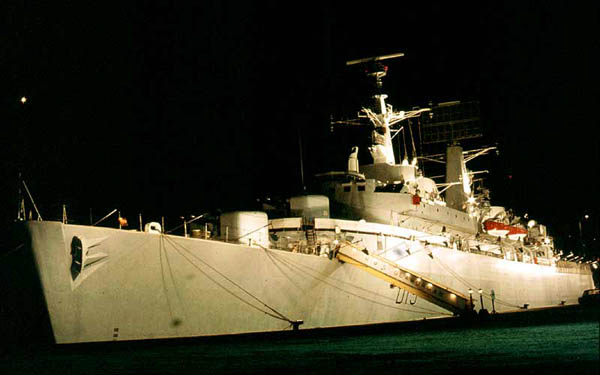
HMS_Glamorgan_Rio_de_Janeiro_Feb1972
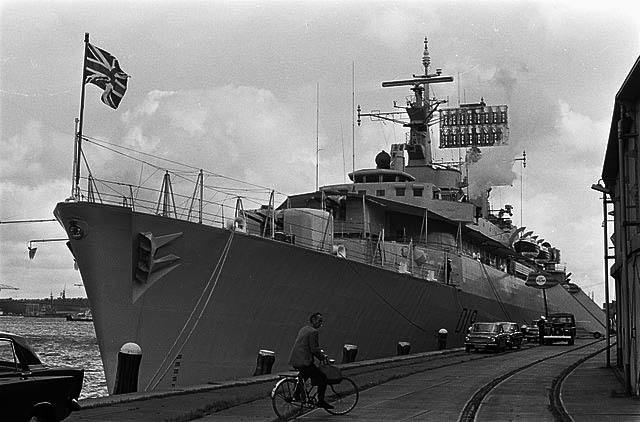
glamorgan_Amsterdam_1970s
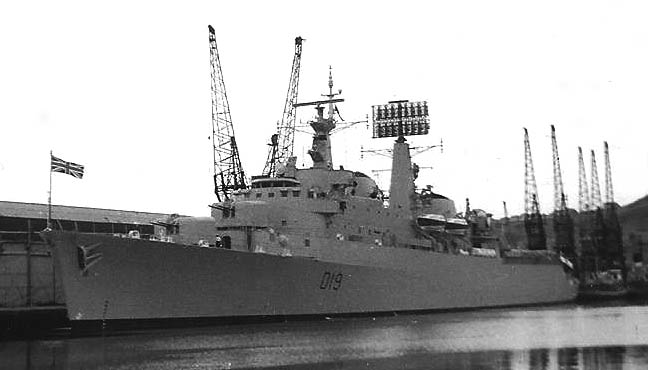
HMS_Glamorgan_Swansea_Docks_c1972
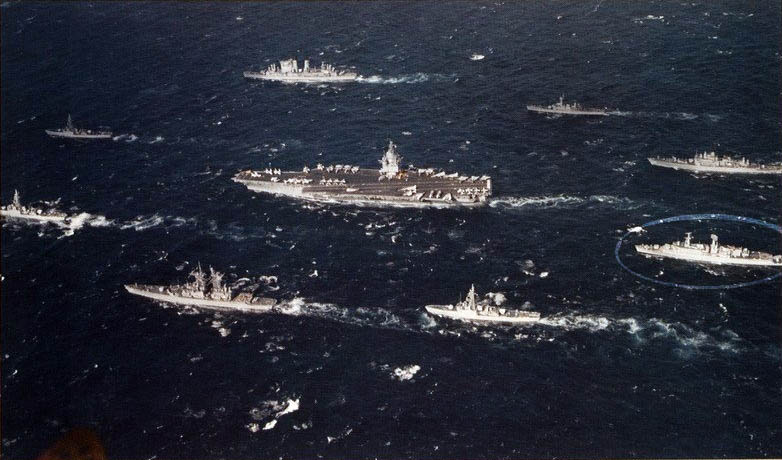
USS_Enterprise_TF_country-glam-back_c1976
HMS Antrim 1970-1984
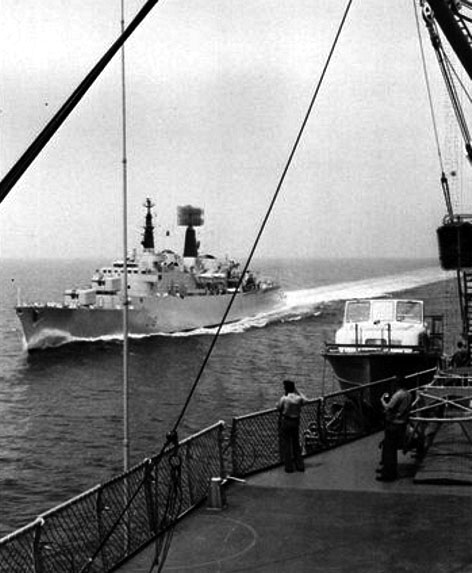
HMS Antrim in the Mediterranean, 1972
In 1940-71 HMS Antrim’s first captain was H W E Hollins RN. She alternated between cruises and home waters exercizes, between the north sea and north Atlantic. In 1982 she was called to be part of the task force for sent in the Falklands, as flagship of Operation Paraquet: This was basically an operation to retake South Georgia in April 1982. She took part in a round of shelling, expending 400 of her 5.5 inches stocks. Her helicopter was the famous Westland Wessex HAS.Mk3 that rescues 16 SAS from Fortuna Glacier after their successful raid, as well as the crew from two previous crashed helicopters. She also took part in the detection leading to the sinking of the Argentinian submarine Santa Fe, first ever ASW operation by helicopters. Captain Lagos surrendered in HMS Antrim’s wardroom. Later she took part in the supporting force during the landing in San Carlos and was bombed by Argentine Skyhawks: 12 narrowly missed her, but one 1,000 lb (450 kg) bomb penetrated her decks, but fortunately failed to explode. After 10 hours she was disabled and removes, while HMS Antrim fired her Sea Slug on an incoming A-4 Skyhawk, missing. She went back home a hero but spent inly two more years in service. She was decommissiond and later sold to Chile, on 22 June 1984.
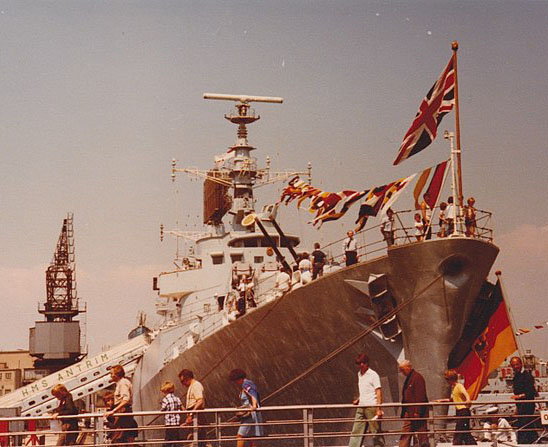
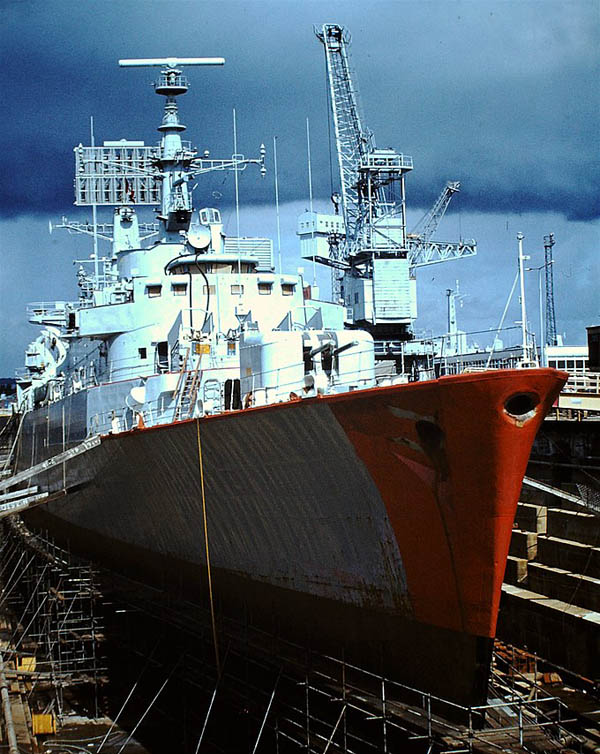
HMS Antrim in 1982, Falklands war
HMS Norfolk 1970-1982
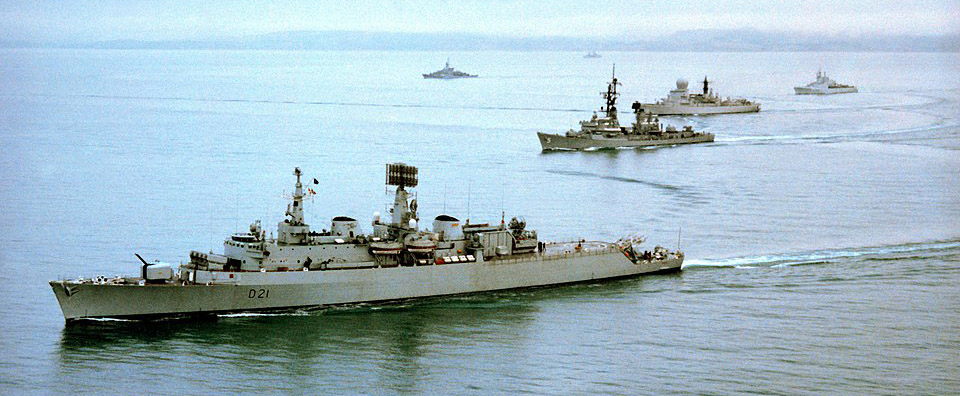
Norfork as lead ship in 1976 Standing Naval Force Atlantic.
HMS Norfolk was first commissioned on 7 March 1970, participating in Portsmouth Navy Days. In 1972 a refit saw her ‘B’ exchanged for four Exocet launchers, the first RN warship to be so, and first with three missile systems. Recommissioned in 1974 she started the first of numerous deployments to the Indian Ocean, Mediterranean and South Pacific. Still fitted with the Mk 2 Sea Slug she never received new computer command and control fitted on the second group and went to third line roles. In September 1976, she flew the Queen’s Colour in Sweden. Aslo she took over the UK’s commitment to Standing Naval Force Atlantic. She visited Fremantle, Australia in 1979, holding there a Court Martial and commemorating 150 years of the founding of Western Australia. She was decommissioned in 1981 and took on the Dartmouth Training Ship role. Close to be BU she was offered as sale, proposed to New Zealand in 1981, but in 1982 she was sold to Chile instead, one of four of the class, and the first in that case. Other were sold in 1984, 1986 and 1987.
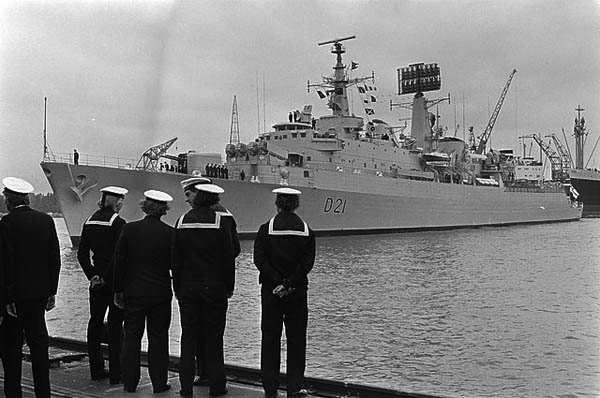
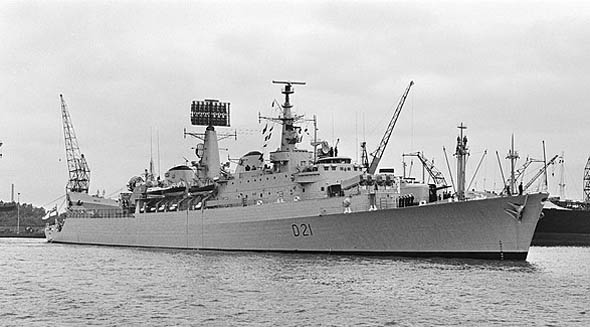
HMS Norfolk in Amsterdam, 1976


 Latest Facebook Entry -
Latest Facebook Entry -  X(Tweeter) Naval Encyclopedia's deck archive
X(Tweeter) Naval Encyclopedia's deck archive Instagram (@navalencyc)
Instagram (@navalencyc)





 French Navy
French Navy Royal Navy
Royal Navy Russian Navy
Russian Navy Armada Espanola
Armada Espanola Austrian Navy
Austrian Navy K.u.K. Kriegsmarine
K.u.K. Kriegsmarine Dansk Marine
Dansk Marine Nautiko Hellenon
Nautiko Hellenon Koninklije Marine 1870
Koninklije Marine 1870 Marinha do Brasil
Marinha do Brasil Osmanlı Donanması
Osmanlı Donanması Marina Do Peru
Marina Do Peru Marinha do Portugal
Marinha do Portugal Regia Marina 1870
Regia Marina 1870 Nihhon Kaigun 1870
Nihhon Kaigun 1870 Preußische Marine 1870
Preußische Marine 1870 Russkiy Flot 1870
Russkiy Flot 1870 Svenska marinen
Svenska marinen Søværnet
Søværnet Union Navy
Union Navy Confederate Navy
Confederate Navy Armada de Argentina
Armada de Argentina Imperial Chinese Navy
Imperial Chinese Navy Marinha do Portugal
Marinha do Portugal Mexico
Mexico Kaiserliche Marine
Kaiserliche Marine 1898 US Navy
1898 US Navy Sovietskiy Flot
Sovietskiy Flot Royal Canadian Navy
Royal Canadian Navy Royal Australian Navy
Royal Australian Navy RNZN Fleet
RNZN Fleet Chinese Navy 1937
Chinese Navy 1937 Kriegsmarine
Kriegsmarine Chilean Navy
Chilean Navy Danish Navy
Danish Navy Finnish Navy
Finnish Navy Hellenic Navy
Hellenic Navy Polish Navy
Polish Navy Romanian Navy
Romanian Navy Turkish Navy
Turkish Navy Royal Yugoslav Navy
Royal Yugoslav Navy Royal Thai Navy
Royal Thai Navy Minor Navies
Minor Navies Albania
Albania Austria
Austria Belgium
Belgium Columbia
Columbia Costa Rica
Costa Rica Cuba
Cuba Czechoslovakia
Czechoslovakia Dominican Republic
Dominican Republic Haiti
Haiti Hungary
Hungary Honduras
Honduras Estonia
Estonia Iceland
Iceland Eire
Eire Equador
Equador Iran
Iran Iraq
Iraq Latvia
Latvia Liberia
Liberia Lithuania
Lithuania Mandchukuo
Mandchukuo Morocco
Morocco Nicaragua
Nicaragua Persia
Persia San Salvador
San Salvador Sarawak
Sarawak Uruguay
Uruguay Venezuela
Venezuela Zanzibar
Zanzibar Warsaw Pact Navies
Warsaw Pact Navies Bulgaria
Bulgaria Hungary
Hungary

 Bundesmarine
Bundesmarine Dutch Navy
Dutch Navy Hellenic Navy
Hellenic Navy Marina Militare
Marina Militare Yugoslav Navy
Yugoslav Navy Chinese Navy
Chinese Navy Indian Navy
Indian Navy Indonesian Navy
Indonesian Navy JMSDF
JMSDF North Korean Navy
North Korean Navy Pakistani Navy
Pakistani Navy Philippines Navy
Philippines Navy ROKN
ROKN Rep. of Singapore Navy
Rep. of Singapore Navy Taiwanese Navy
Taiwanese Navy IDF Navy
IDF Navy Saudi Navy
Saudi Navy Royal New Zealand Navy
Royal New Zealand Navy Egyptian Navy
Egyptian Navy South African Navy
South African Navy






























 Ukrainian Navy
Ukrainian Navy dbodesign
dbodesign